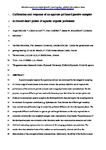Calibration and response of an agarose gel based passive sampler to record short pulses of aquatic organic pollutants
| dc.contributor.author | Belles, A | en |
| dc.contributor.author | Alary, C | en |
| dc.contributor.author | Aminot, Y | en |
| dc.contributor.author | Readman, JW | en |
| dc.contributor.author | Franke, C | en |
| dc.date.accessioned | 2017-06-01T14:47:38Z | |
| dc.date.available | 2017-06-01T14:47:38Z | |
| dc.date.issued | 2017-04-01 | en |
| dc.identifier.issn | 0039-9140 | en |
| dc.identifier.other | C | en |
| dc.identifier.uri | http://hdl.handle.net/10026.1/9403 | |
| dc.description | publisher: Elsevier articletitle: Calibration and response of an agarose gel based passive sampler to record short pulses of aquatic organic pollutants journaltitle: Talanta articlelink: http://dx.doi.org/10.1016/j.talanta.2016.12.010 content_type: article copyright: © 2016 Elsevier B.V. All rights reserved. | en |
| dc.description.abstract |
A passive sampler inspired from previous devices was developed for the integrative sampling of a broad range of contaminants in the water column. Our primary objective was to improve the performance of the device to provide accurate and averaged pollutant water concentrations. For this purpose, an agarose diffusive gel was used as the boundary layer that drives the analyte uptake rate. Contrary to conventional passive samplers, the developed device does not require the sampling rates to be corrected for exposure conditions (e.g. hydrodynamic flow) because the diffusive gel boundary layer selected was sufficiently large to control the pollutant diffusion rate from the aqueous phase. The compounds diffusion coefficients in agarose gel and the gel thickness are the only required data to accurately calculate the time weighted averaged water concentration of pollutants. The performance of the developed sampler was evaluated in the laboratory under two contamination scenarios and in the field in 8 contrasting exposure sites for a selection of 16 emerging pollutants and pesticides. The results show that detection limits of this method are environmentally relevant and allow the determination of the averaged pollutant concentrations. Additionally, the ability of the device to sense very short contamination pulses (5-320min) was evaluated through a theoretical approach and laboratory tests. Results show that the device is suitable for sampling contamination pulses as short as 5min without deviation from the actual average concentrations of pollutants. | |
| dc.format.extent | 1 - 9 | en |
| dc.language.iso | en | en |
| dc.title | Calibration and response of an agarose gel based passive sampler to record short pulses of aquatic organic pollutants | en |
| dc.type | Journal Article | |
| plymouth.volume | 165 | en |
| plymouth.publication-status | Published | en |
| plymouth.journal | Talanta | en |
| dc.identifier.doi | 10.1016/j.talanta.2016.12.010 | en |
| plymouth.organisational-group | /Plymouth | |
| plymouth.organisational-group | /Plymouth/Faculty of Science and Engineering | |
| plymouth.organisational-group | /Plymouth/REF 2021 Researchers by UoA | |
| plymouth.organisational-group | /Plymouth/REF 2021 Researchers by UoA/UoA06 Agriculture, Veterinary and Food Science | |
| plymouth.organisational-group | /Plymouth/REF 2021 Researchers by UoA/UoA06 Agriculture, Veterinary and Food Science/UoA06 Agriculture, Veterinary and Food Science MANUAL | |
| plymouth.organisational-group | /Plymouth/Users by role | |
| dcterms.dateAccepted | 2016-12-06 | en |
| dc.rights.embargodate | 2017-12-07 | en |
| dc.rights.embargoperiod | 12 months | en |
| rioxxterms.versionofrecord | 10.1016/j.talanta.2016.12.010 | en |
| rioxxterms.licenseref.uri | http://www.rioxx.net/licenses/under-embargo-all-rights-reserved | en |
| rioxxterms.licenseref.startdate | 2017-04-01 | en |
| rioxxterms.type | Journal Article/Review | en |


